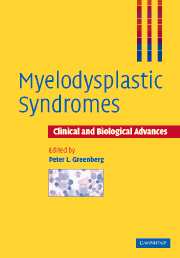Book contents
- Frontmatter
- Contents
- List of contributors
- Preface
- 1 Clinical and prognostic characterization of myelodysplastic syndromes
- 2 Morphologic classifications of myelodysplastic syndromes: French–American–British (FAB) and World Health Organization (WHO)
- 3 Pathogenetic mechanisms underlying myelodysplastic syndromes
- 4 Cytogenetic abnormalities in myelodysplastic syndromes
- 5 Molecular mechanisms and gene expression patterns in myelodysplastic syndromes
- 6 Immunologic mechanisms and treatment of myelodysplastic syndromes
- 7 Biologically targeted therapies for myelodysplastic syndromes
- 8 Supportive care in myelodysplastic syndromes: hemopoietic cytokine and iron chelation therapy
- 9 Hematopoietic cell transplantation for myelodysplastic syndromes
- 10 Health-related quality of life for those with myelodysplastic syndrome: conceptualization, measurement, and implications for research and practice
- Index
- Plate section
- References
6 - Immunologic mechanisms and treatment of myelodysplastic syndromes
Published online by Cambridge University Press: 22 August 2009
- Frontmatter
- Contents
- List of contributors
- Preface
- 1 Clinical and prognostic characterization of myelodysplastic syndromes
- 2 Morphologic classifications of myelodysplastic syndromes: French–American–British (FAB) and World Health Organization (WHO)
- 3 Pathogenetic mechanisms underlying myelodysplastic syndromes
- 4 Cytogenetic abnormalities in myelodysplastic syndromes
- 5 Molecular mechanisms and gene expression patterns in myelodysplastic syndromes
- 6 Immunologic mechanisms and treatment of myelodysplastic syndromes
- 7 Biologically targeted therapies for myelodysplastic syndromes
- 8 Supportive care in myelodysplastic syndromes: hemopoietic cytokine and iron chelation therapy
- 9 Hematopoietic cell transplantation for myelodysplastic syndromes
- 10 Health-related quality of life for those with myelodysplastic syndrome: conceptualization, measurement, and implications for research and practice
- Index
- Plate section
- References
Summary
Background
The concept that an immune-mediated response directed against hematopoietic cells can cause failure of the bone marrow leading to pancytopenia arose from early experiences with the use of bone marrow transplants to treat severe aplastic anemia (SAA). In 1976 Mathé et al. in Paris reported a curious case in which a patient transplanted for SAA from a human leukocyte antigen (HLA)-identical sibling donor subsequently achieved full hematologic recovery without any vestige of donor marrow engraftment. Subsequently Jeannet et al. reported sustained autologous hematological recovery in 3 SAA patients receiving antithymocyte globulin (ATG) and a one-haplotype mismatched marrow transplant. At the time the stimulus to autologous hematological recovery was thought to be conferred by the transiently engrafting donor marrow itself, and experiments by Speck & Kissling using mismatched grafts and ATG in aplastic rabbits seemed to support this view. However, Ascensão et al. in 1976 made the critical observation that in vitro exposure of aplastic anemia patients' bone marrow to ATG caused a dramatic recovery in granulocyte colony formation, while marrow cells from the patients cocultured with normal marrow suppressed colony formation. Such observations pointed to an immune-mediated mechanism in SAA and stimulated Gluckman et al. to treat SAA patients with ATG alone: of 17 patients, 8 had a prompt and sustained hematological recovery. Subsequent extensive laboratory studies and widespread clinical experience have clearly established that the majority of patients with SAA have immune-mediated T-cell-mediated marrow suppression which can be reversed in a high proportion of cases by immunosuppressive treatment with ATG (reviewed by Young et al.).
- Type
- Chapter
- Information
- Myelodysplastic SyndromesClinical and Biological Advances, pp. 147 - 172Publisher: Cambridge University PressPrint publication year: 2005
References
- 1
- Cited by



